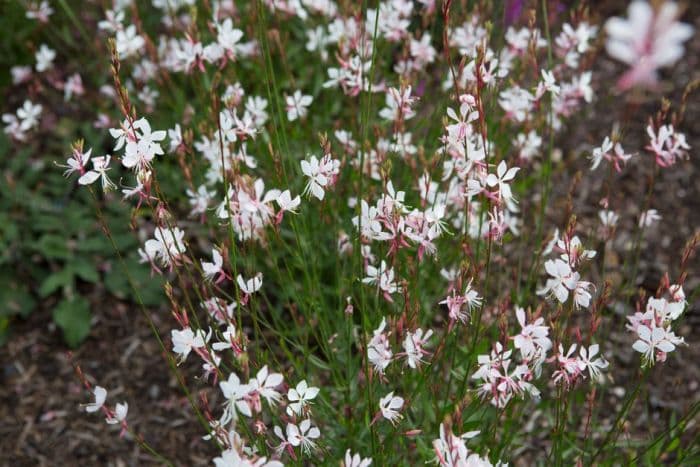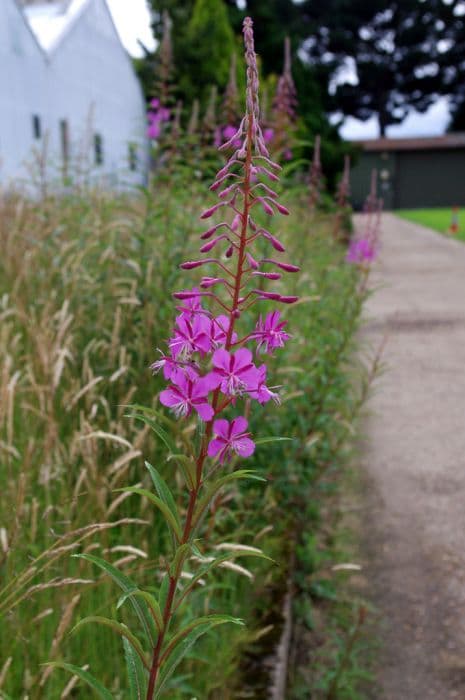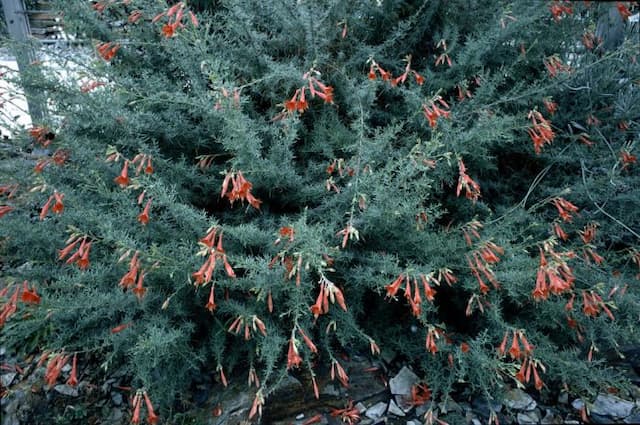White gaura Oenothera lindheimeri 'Whirling Butterflies' (G)

ABOUT
'Whirling Butterflies' is a visually striking plant with a unique and ethereal appearance. It is known for its airy and delicate white flowers that dance atop slender stems, reminiscent of fluttering butterflies. The flowers are characterized by four broad and reflexed petals forming a bowl-like shape, providing a playful elegance to gardens. These white blossoms have a soft and subtle charm that easily draws attention. The foliage of 'Whirling Butterflies' consists of narrow, lance-shaped leaves that are typically a soft green hue, creating a fine textured backdrop that contrasts wonderfully with the lightness of the flowering stems. The leaves are often densely arranged along the stems, which allows the plant to maintain a bushy and full appearance even when not in bloom. The plant's overall graceful structure and long-lasting flowers make it an appealing choice for those looking to add a touch of whimsy to their landscapes.
About this plant
 Names
NamesSynonyms
Lindheimer's Beeblossom, White Gaura, Whirling Butterflies, Gaura.
Common names
Gaura lindheimeri, Gaura lindheimeri var. leucantha, Gaura lindheimeri var. longiflora, Oenothera lindheimeri.
 Toxicity
ToxicityTo humans
Gaura is not known to be toxic to humans. It is generally considered safe and does not typically cause poisoning if ingested.
To pets
Gaura is not known to be toxic to pets. It is generally considered safe and does not typically cause poisoning if ingested by animals such as cats and dogs.
 Characteristics
CharacteristicsLife cycle
Perennials
Foliage type
Deciduous
Color of leaves
Green
Flower color
White
Height
2-3 feet [61-91 cm]
Spread
2-3 feet [61-91 cm]
Plant type
Herb
Hardiness zones
5-9
Native area
North America
Benefits
 General Benefits
General Benefits- Attracts Pollinators: 'Whirling Butterflies' is known to attract bees, butterflies, and other beneficial insects, which are important for pollination.
- Drought Tolerant: This plant is highly drought-tolerant, making it ideal for xeriscaping and low-water-use gardens.
- Long Blooming Season: It provides a long season of bloom, which adds consistent beauty to gardens from spring to fall.
- Deer Resistant: It is generally resistant to deer, which can be an important feature for gardeners in areas where deer predation is a problem.
- Ease of Care: It is relatively easy to care for with no special requirements, ideal for both new and experienced gardeners.
- Landscape Versatility: Its graceful appearance fits well in a variety of garden designs, including cottage gardens, wildflower meadows, and contemporary landscapes.
- Movement: The delicate, swaying stems add movement to the garden, creating a dynamic aesthetic.
- Low Maintenance: It generally requires minimal maintenance such as occasional deadheading to promote more blooms.
- Native Plant Benefits: Being a native plant, it can provide specific advantages to local ecosystems, such as supporting native wildlife.
 Medical Properties
Medical PropertiesThis plant is not used for medical purposes.
 Air-purifying Qualities
Air-purifying QualitiesThis plant is not specifically known for air purifying qualities.
 Other Uses
Other Uses- Plant Marker: The tall, slender stems of Gaura can be used as natural plant markers in a garden. Their distinctive form can help you delineate between different garden sections or act as reference points.
- Photography Subject: With its delicate white flowers that resemble butterflies, Gaura makes an excellent subject for photographers, especially those interested in macro or nature photography.
- Art Inspiration: Artists might use Gaura's unique structure and movement as inspiration for paintings, sculptures, or even fashion designs, capturing the airy, whimsical essence of the plant.
- Dried Flower Arrangements: The stems and seed pods of dried Gaura can be incorporated into dried flower arrangements for a touch of rustic charm.
- Educational Aid: Gaura's lifecycle, which includes a notable transformation from bud to bloom, can be used in educational settings to demonstrate pollination and plant growth processes to students.
- Floral Crafts: The whimsical flowers and seed heads can be used in craft projects, like making bookmarks or pressed flower art.
- Garden Borders: When planted densely, Gaura can form a flowing border that moves in the wind, providing a dynamic edge to garden beds or pathways.
- Eco-Friendly Confetti: The petals of Gaura flowers can be dried and used as a natural, biodegradable confetti for celebrations and weddings.
- Spiritual Practices: In some cultures, white flowers like those of the Gaura plant may be used in ceremonies or spiritual practices as symbols of purity and peace.
- Garden Companionship: Gaura can be planted among vegetables as a companion plant to attract beneficial insects that can aid in the pollination of crops.
Interesting Facts
 Feng Shui
Feng ShuiGaura is not used in Feng Shui practice.
 Zodiac Sign Compitability
Zodiac Sign CompitabilityGaura is not used in astrology practice.
 Plant Symbolism
Plant Symbolism- Delicacy: The plant's common name, "Whirling Butterflies", suggests a sense of lightness and ethereal qualities, much like the delicate and graceful butterfly it resembles.
- Resilience and Hardiness: Although delicate in appearance, Gaura is known for its ability to withstand tough conditions, symbolizing resilience and the ability to endure challenging environments.
- Transformation: Mimicking the flight of butterflies, the Gaura represents change and the beauty of transformation, aligning with the life cycle of butterflies from caterpillars to elegant winged creatures.
- Purity: The white and pink flowers can symbolize purity and innocence, much like many white-flowered plants in different cultures.
- Feminine Beauty: Gaura's gentle sway and subtle flowers have been associated with feminine beauty and softness.
- Attraction: The way the flowers seem to float and dance in the breeze can symbolize attraction and the subtle ways living things interact and connect in nature.
 Water
WaterThe Gaura, also known as the 'Whirling Butterflies', should be watered deeply to encourage root development, approximately once a week with about one gallon of water for established plants during the growing season. In the absence of rain, you may need to water twice a week, particularly in very hot, dry periods. During the winter months, reduce watering to every few weeks, just to prevent the soil from completely drying out. Water the plants at the base to avoid wetting the foliage, which can lead to fungal diseases. Always check the soil moisture before watering; Gaura prefers slightly moist but well-drained soil and does not like to be waterlogged.
 Light
LightGaura thrives in full sun, requiring at least six to eight hours of direct sunlight each day for optimal flowering. It's best to plant them in a bright spot where they receive unfiltered sunlight. However, in very hot climates, Gaura can benefit from light afternoon shade to protect from the scorching sun.
 Temperature
TemperatureGaura is cold-hardy and can survive in temperatures as low as 10 degrees Fahrenheit, though temperatures below this can damage or kill the plant. They grow best in temperatures ranging from 60 to 85 degrees Fahrenheit. It is important to protect the plant from frosts, which can be damaging, especially for new spring growth.
 Pruning
PruningGaura, or 'Whirling Butterflies', should be pruned to remove dead or faded flowers and to shape the plant which encourages more blooms and a bushier growth habit. It's best to prune them in early spring to remove any damaged or dead stems and to promote new growth. The plant can also be cut back by half in midsummer if it starts to look leggy or is not flowering well.
 Cleaning
CleaningAs needed
 Soil
SoilGaura lindheimeri 'Whirling Butterflies' prefers well-draining soil, with a mix containing loam, compost, and a bit of sharp sand to enhance drainage. A slightly acidic to neutral pH of 5.5 to 7.0 suits the plant well.
 Repotting
RepottingGaura lindheimeri 'Whirling Butterflies' does not need to be repotted frequently; repotting every 2-3 years or when it outgrows its current container is sufficient.
 Humidity & Misting
Humidity & MistingGaura lindheimeri 'Whirling Butterflies' tolerates a wide range of humidity levels and does well in the average humidity found in most outdoor garden environments.
 Suitable locations
Suitable locationsIndoor
Place Gaura 'Whirling Butterflies' in bright indirect light indoors.
Outdoor
Plant Gaura 'Whirling Butterflies' in full sun with good air circulation.
Hardiness zone
5-9 USDA
 Life cycle
Life cycleGaura lindheimeri 'Whirling Butterflies' begins its life as a seed, which germinates in spring when conditions of light and temperature are favorable. Emerging as seedlings with a set of initial leaves, the plants develop a rosette of foliage at the soil level. Through the growing season, the plant develops a strong root system and elongates its stems, eventually producing tall spikes with buds. These buds blossom into the characteristic white to pink flowers, resembling butterflies fluttering on long wands, primarily in late spring to autumn. After pollination, typically by bees and butterflies, the flowers develop into small nut-like fruits containing seeds. In the winter, the plant may die back, especially in colder climates, but it is a perennial and will regrow from the rootstock the following spring.
 Propogation
PropogationPropogation time
Spring to Summer
Propogation: Oenothera lindheimeri 'Whirling Butterflies', more commonly known as Gaura, is a perennial plant that is best propagated by division or by taking stem cuttings. The most popular way to propagate Gaura is by taking stem cuttings in the spring just as new growth begins to show. To propagate via cuttings, select a healthy, non-flowering stem and cut a piece about 4 to 6 inches (10 to 15 cm) in length. Strip the lower leaves off, leaving only a few at the top, and dip the cut end into a rooting hormone powder to encourage root development. Then, plant the cutting into a pot filled with a moistened mixture of half peat and half perlite or sand. Cover the pot with a plastic bag to maintain humidity and place it in indirect sunlight. Keep the soil moist but not waterlogged, and roots should form within a few weeks, at which point it can be transplanted to a larger pot or directly into the garden.









